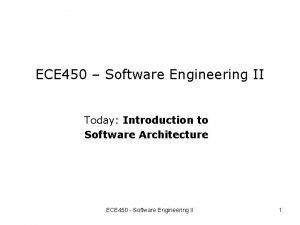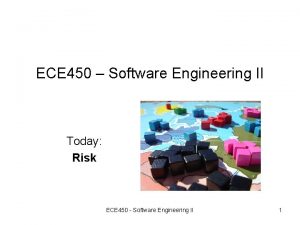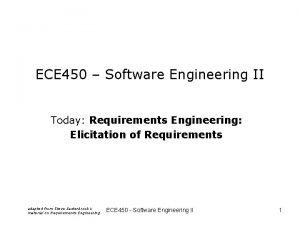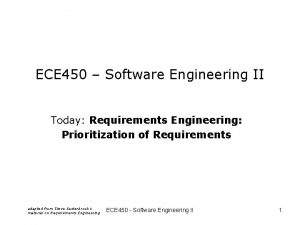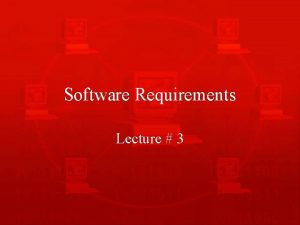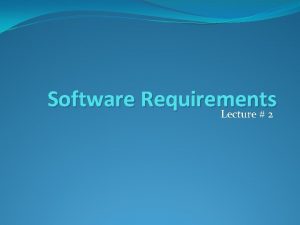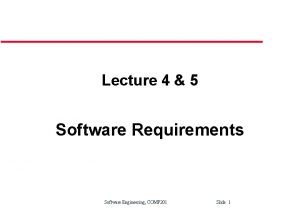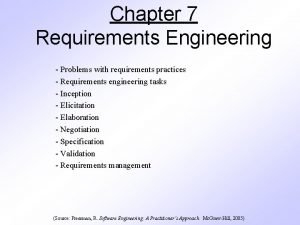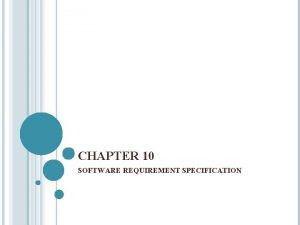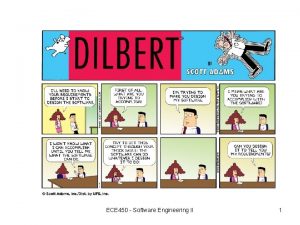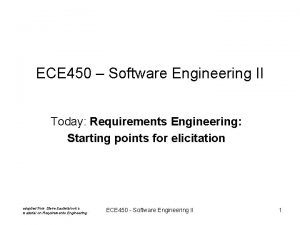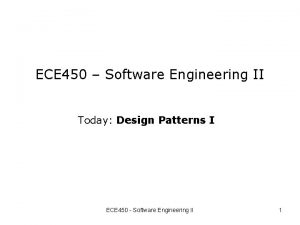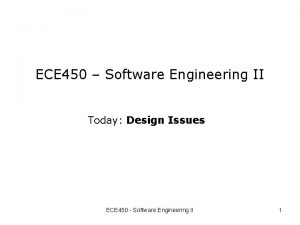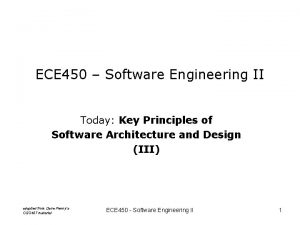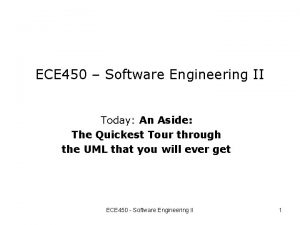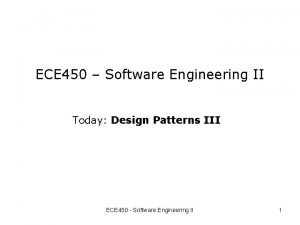ECE 450 Software Engineering II Today Requirements Engineering














- Slides: 14

ECE 450 – Software Engineering II Today: Requirements Engineering: Elicitation of Requirements adapted from Steve Easterbrook’s material on Requirements Engineering ECE 450 - Software Engineering II 1

Difficulties of elicitation • Thin spread of domain knowledge – It is rarely available in an explicit form (i. e. not written down) – …distributed across many sources – …with conflicts between knowledge from different sources • Tacit knowledge (The “say-do” problem) – People find it hard to describe knowledge they regularly use • Limited Observability – The problem owners might be too busy coping with the current system – Presence of an observer may change the problem • E. g. Probe Effect; • E. g. Hawthorne Effect • Bias – People may not be free to tell you what you need to know – People may not want to tell you what you need to know • The outcome will affect them, so they may try to influence you (hidden agendas) ECE 450 - Software Engineering II 2

Example • Loan approval department in a large bank – The analyst is trying to elicit the rules and procedures for approving a loan • Why this might be difficult: – Implicit knowledge: • There is no document in which the rules for approving loans are written down – Conflicting information: • Different bank staff have different ideas about what the rules are – Say-do problem: • The loan approval process described to you by the loan approval officers is quite different from your observations of what they actually do – Probe effect: • The loan approval process used by the officers while you are observing is different from the one they normally use – Bias: • The loan approval officers fear that your job is to computerize their jobs out of existence, so they are deliberately emphasizing the need for case-by-case discretion (to convince you it has to be done by a human!) ECE 450 - Software Engineering II 3

Elicitation Techniques • • Traditional techniques – – – Ethnographic techniques Introspection Reading existing documents Analyzing hard data Interviews • Participant Observation • Enthnomethodology – Discourse Analysis • Conversation Analysis • Speech Act Analysis • Open-ended • Structured – Surveys / Questionnaires – Meetings • Collaborative techniques – Focus Groups • Brainstorming • JAD/RAD workshops – Prototyping – Participatory Design Contextual (social) approaches – Sociotechnical Methods • Soft Systems Analysis • Cognitive techniques – Task analysis – Protocol analysis – Knowledge Acquisition Techniques • Card Sorting • Repertory Grids ECE 450 - Software Engineering II 4

Background reading • Sources of information: – company reports, organization charts, policy manuals, job descriptions, reports, documentation of existing systems, etc. • Advantages: – Helps you get an understanding of an organization before meeting the people who work there. – Helps to prepare for other types of fact finding • e. g. by being aware of the business objectives of the organization. – may provide detailed requirements for the current system. • Disadvantages: – written documents often do not match up to reality. – Can be long-winded with much irrelevant detail • Appropriate for – Whenever you not familiar with the organization being investigated. ECE 450 - Software Engineering II 5

“Hard data” and Sampling • Hard data includes facts and figures… • Forms, Invoices, financial information, … • Reports used for decision making, … • Survey results, marketing data, … • Sampling – Sampling used to select representative set from a population • Purposive Sampling - choose the parts you think are relevant without worrying about statistical issues • Simple Random Sampling - choose every kth element • Stratified Random Sampling - identify strata and sample each • Clustered Random Sampling - choose a representative subpopulation and sample it – Sample Size is important • balance between cost of data collection/analysis and required significance – Process: • • Decide what data should be collected - e. g. banking transactions Determine the population - e. g. all transactions at 5 branches over one week Choose type of sample - e. g. simple random sampling Choose sample size - e. g. every 20 th transaction ECE 450 - Software Engineering II 6

Interviews • Types: – Structured - agenda of fairly open questions – Open-ended - no pre-set agenda • Advantages – Rich collection of information – Good for uncovering opinions, feelings, goals, as well as hard facts – Can probe in depth & adapt followup questions to what they tell you • Disadvantages – Large amount of qualitative data can be hard to analyze – Hard to compare different respondents – Interviewing is a difficult skill to master • Watch for – – Unanswerable questions (“how do you tie your shoelaces? ”) Tacit knowledge (and post-hoc rationalization) Removal from context Interviewer’s attitude may cause bias (e. g. variable attentiveness) ECE 450 - Software Engineering II 7

Interviewing tips • Starting off… – Begin the interview with an innocuous topic to set people at ease • e. g. the weather, the score in last night’s hockey game • e. g. comment on an object on the person’s desk: “…what a beautiful photograph! Did you take that? ” • Ask if you can record the interview – Put the recorder where it is visible – Let interviewee know they can turn it off at any time. • Ask easy questions first – perhaps personal information • e. g. “How long have you worked in your present position? ” • Follow up interesting leads – E. g. if you hear something that indicates your plan of action may be wrong, • e. g. , “Could we pursue what you just said a little further? ” • Ask open-ended questions towards the end • e. g. “Is there anything else you would like to add? ” ECE 450 - Software Engineering II 8

Questionnaires • Advantages – Can quickly collect info from large numbers of people – Can be administered remotely – Can collect attitudes, beliefs, characteristics • Disadvantages – Simplistic (presupposed) categories provide very little context • No room for users to convey their real needs • Watch for: – – – – • Bias in sample selection Bias in self-selecting respondents Small sample size (lack of statistical significance) Open ended questions (very hard to analyze!) Leading questions (“have you stopped beating your wife? ”) Appropriation (“What is this a picture of? ”) Ambiguous questions (I. e. not everyone is answering the same question) REMEMBER TO HAVE A PILOT RUN OF YOUR QUESTIONNAIRE! ECE 450 - Software Engineering II 9

Meetings • Used for summarization and feedback – E. g. meet with stakeholders towards the end of each stage: • to discuss the results of the information gathering stage • to conclude on a set of requirements • to agree on a design etc. – Use the meeting to confirm what has been learned, talk about findings • Meetings are an important managerial tool – Used to move a project forward. – Every meeting should have a clear objective: • E. g. presentation, problem solving, conflict resolution, progress analysis, gathering and merging of facts, training, planning, . . . – Plan the meeting carefully: • • • Schedule the meeting and arrange for facilities Prepare an agenda and distribute it well in advance Keep track of time and agenda during the meeting Follow up with a written summary to be distributed to meeting participants Special rules apply formal presentations, walkthroughs, brainstorming, etc. ECE 450 - Software Engineering II 10

Group Elicitation Techniques • Types: – Focus Groups – Brainstorming • Advantages – More natural interaction between people than formal interview – Can gauge reaction to stimulus materials (e. g. mock-ups, storyboards, etc) • Disadvantages – – May create unnatural groups (uncomfortable for participants) Danger of Groupthink May only provide superficial responses to technical questions Requires a highly trained facilitator • Watch for – sample bias – dominance and submission ECE 450 - Software Engineering II 11

Joint/Rapid Application Development (JAD/RAD) • JAD & RAD Principles: – Group Dynamics - use workshops instead of interviews – Visual Aids • Lots of visualization media, e. g. wall charts, large monitors, graphical interfaces – Organized, Rational Process • Techniques such as brainstorming and top-down analysis – WYSIWYG Documentation Approach • each JAD session results in a document which is easy to understand is created and agreed upon during the session • Notes: – Choose workshop participants carefully • they should be the best people possible representing various stakeholder groups – Workshop should last 3 -5 days. • • Must turn a group of participants into a team - this takes 1 -2 days. Session leader makes sure each step has been completed thoroughly. Session leader steps in when there are differences of opinion - “open issues”. Meeting room should be well-equipped for presentations, recording etc. ECE 450 - Software Engineering II 12

Participant Observation • Approach – Observer spends time with the subjects • Joining in long enough to become a member of the group • Hence appropriate for longitudinal studies • Advantages – Contextualized – Reveals details that other methods cannot • Disadvantages – Extremely time consuming! – Resulting ‘rich picture’ is hard to analyze – Cannot say much about the results of proposed changes • Watch for – going native! ECE 450 - Software Engineering II 13

Ethnomethodology • Basis – Social world is ordered • The social order may not be obvious, nor describable from common sense – The social order cannot be assumed to have an a priori structure • Social order is established on a moment-to-moment basis through participants’ collective actions (no pre-existing structures) • i. e. social order only observable when an observer immerses herself in it. – Observation should be done in a natural setting – Need to consider how meanings develop and evolve within context • “Use the members’ own Categories” – Most conventional approaches assume preexisting categories • This may mislead the observer (e. g. appropriation) – Ethnography attempts to use the subjects’ own categories • What categories (concepts) do they use themselves to order the social world? – What methods do people use to make sense of the world around them? • Use the same methods members use during observation • E. g by developing a legitimate role within the community under observation. ECE 450 - Software Engineering II 14
 Penyiku dari perbandingan trigonometri sin 30° adalah
Penyiku dari perbandingan trigonometri sin 30° adalah Ece 450
Ece 450 Ece 450
Ece 450 Ece 450
Ece 450 Ece 450
Ece 450 Ece 450
Ece 450 Inverse requirements in software engineering
Inverse requirements in software engineering Inverse requirements
Inverse requirements System requirements document
System requirements document Requirements discovery techniques in software engineering
Requirements discovery techniques in software engineering Software requirement specification for atm system
Software requirement specification for atm system What is domain requirements in software engineering
What is domain requirements in software engineering Domain requirements in software engineering
Domain requirements in software engineering Problems of requirements in software engineering
Problems of requirements in software engineering Srs software engineering
Srs software engineering

